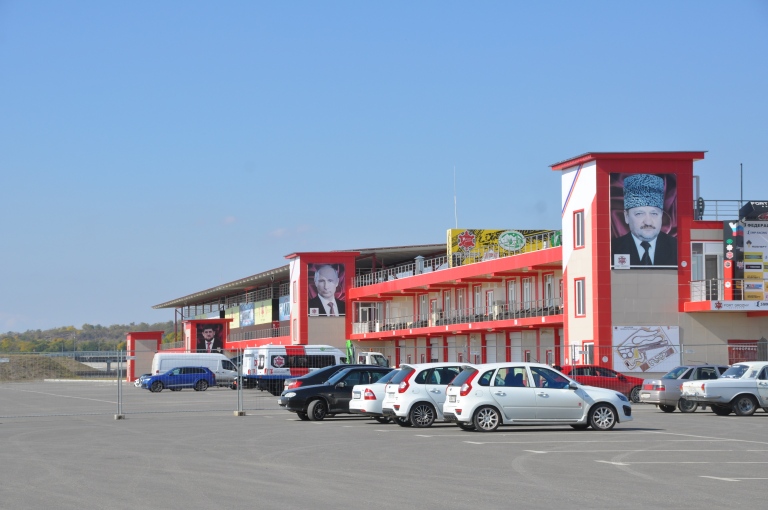From the start, Chechnya proving to be eventful already! Look at my reception upon landing…


No, this wasn’t for me. Nor was it for the many, many dudes on the flight with me. Nor was it for all the Abe Lincoln beards on these dudes.
Russian news the last couple days has been full of a story on orphan children returning home after being taken by their parents from Chechnya to Iraq and Syria upon joining ISIS. A Canadian film crew spent the entire flight sitting behind me debating frames and takes, it wasn’t until nearly the end of our flight that I found out five of these children were on our flight home. We walked off the airstair to at least 5 film crews and a handful of Chechen dignitaries…
Welcome to Chechnya!
I don’t want to be a snooze, but there is no point in coming to Chechnya and not understanding the historical and political situation with Mother Russia. Maybe you know that Russia likes to blame all their terrorism problems on the Chechens, or maybe you don’t, but Chechnya, a 95% Muslim-majority republic in the Russian Caucasus, is like Russia’s Big Bad Extremist Central. This place was shaped by their history with Russia and now runs pretty much only on their political relationship with Russia so I will run through these real quick.
Many people only first heard of Chechnya after the recent Boston bombing and know it only in this context, but the Chechens have a long-running turbulent history particularly since their conquest by Russia’s armies in the 19th century. Even when the Soviets were able to transform and modernize much of the USSR without resistance, the Chechen highlands remained a “no-go zone” for much of the 1920s and 1930s. If there had been a ranking of ethnic groups within the multiethnic USSR reflecting successful adoption of Soviet influence and rule the stubborn Chechen highlanders would have ranked the lowest and most resistant, and the Soviets engaged in many pacification campaigns in these years like their predecessors.
In 1944 in the midst of the Stalinist purges, Chechnya saw a mass deportation as a final solution to the “Chechen problem” – total ethnic cleansing. The racist view held against the Caucasian Muslims was as prevalent in the USSR as the more widely recognized problem of anti-Semitism. Villages that resisted saw residents shot and burned aliveness much worse. All Chechens were directly or indirectly related to somebody that died in the deportation of 1944. Among the Chechens burnt alive in the slaughter were the grandmother, aunt, and two cousins of an infant named Dzhokhar Dudayev. This is the same Dudayev that later lead his people as President against Russia in the first Chechen War 1994-1996.
I think it’s important to note that it was the memory of the deportation, rather than any concept of “jihad” with the Russian “infidel,” that drove the secularized Chechen leadership into a secessionist war with the Russians for national independence. The first Chechen War more represented a nationalist conflict in nature where an Islamic dimension was almost nonexistent. Dudayev, the undisputed leader of the first war, was a former Soviet general whose knowledge of Islam was minimal. Today other influences are getting mixed in, economics is also a factor pushing people towards joining extremist groups, and the situation has gotten so severe that another secessionist war feels like it’s on the cusp of starting again.
Grozny – Capital of Chechnya
Chechens have a reputation of being a militant group, known for their fighting skills in a land where blood feuds, raids, and clan warfare were a way of life. In 1813 when the Caucasus region came under Russian Empire rule, the local people (namely the Chechens) resisted with constant raids on territories around that acknowledged Russian rule. A brutal general was sent down to get things under control and the Russian army firmly crushed the resistance, in the process creating their own line of fortifications whose main outpost was a fortress in the lowlands which they named “Grozny” which translates into “The Terrible” or, more accurately, “The Foreboding.” When the conflict between the Empire and the local population finally ended, trade developed and the fortress evolved into a city. When oil was found at the end of the 19th century Grozny transformed into one of the largest industrial centers in the Caucasus.


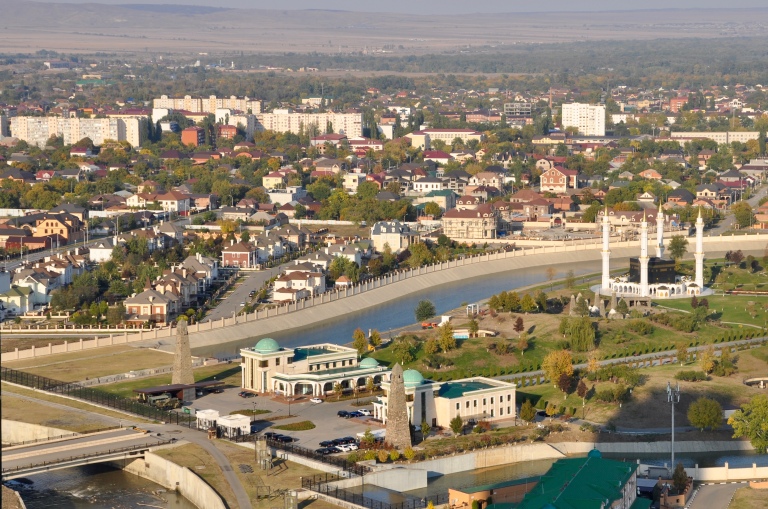
To the left of this is Ramzan Kadyrov’s private residence, nobody is allowed to take pictures in that direction.
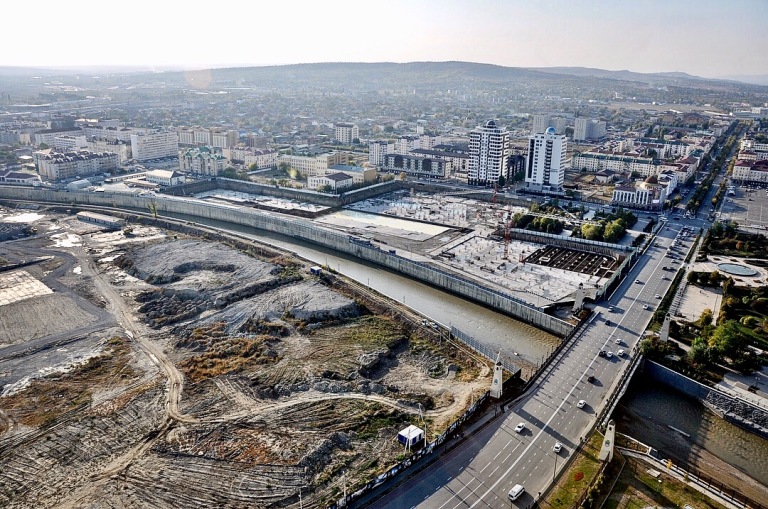
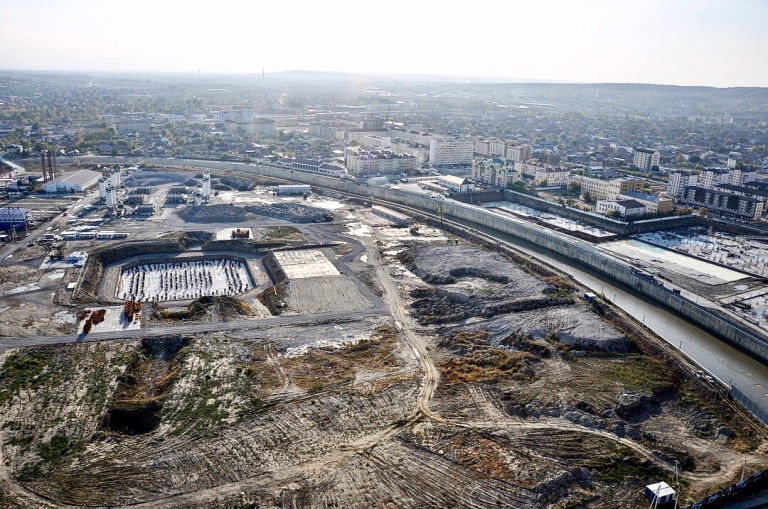
Here you see – All around Grozny are massive empty fields of abandoned industry. After the second Chechen War, the Russians halted and controlled most of Chechnya’s industrial activity. All around are decrepit processing plans, manufacturing factories, warehouses etc. Particularly in Chechnya’s oil industry which next to Azerbaijan was so rich that the Nazis pushed towards the Caspian for it during WW2 (and failed). Russia bombed the processing plants during the war and are now not allowing any further development to build the industry back up.
Past empty in any viable industry development, the city of Grozny feels very empty physically. Chechnya is facing a massive youth and brain drain given the lack of opportunities here. Villages are not growing, most are emptying out, and the streets of Grozny are eerily empty during both day and night. Russia is choking Chechnya out in order to control it and force their dependence.
Since the Tsarist era Grozny has survived a lot – the revolutionary years, fight against the Whites, defence during WW2, deportation of its population to the Kazakh and Kyrgyz steppes in 1944, then finally the ethnic turmoil that led to the first, then the second Chechen war. Despite all this history the current population and architecture of Grozny have little in common with historical Grozny given that the city has been flattened by military campaigns and rebuilt entirely twice. After the second Chechen war the UN declared Grozny the “most destroyed city” on earth.
The whole city has been leveled a couple times so everything has been newly built, and particularly in the center of the city in a very gaudy, Dubai-esque sort of way. Take for example the Grozny City Complex, a bizarre, newly built complex of high rises that sits smack in the middle of Grozny across the river from the central mosque, a mix of hotel, business centers, and whatever else. These lights are flashing and moving, changing all colors of the rainbow, scrolling neon messages to epileptic seizure level.
If there is one name you need to know in Chechnya, it’s Akhmat Kadyrov (pronounced Ka-DEE-rov). He was chief mufti of Chechnya during and after the 1st Chechen War (called the Russian War here in Chechnya), then switched sides to the Russian government for the 2nd Chechen War after which he was made President of the Chechen Republic. This lasted a whole 8 months before he was assassinated at the football stadium by a bomb placed under his seat. Why do you need to know this name? Because here in Grozny, everything is named after him. Buildings, the main mosque, the football team, the autodrome, the avenues, companies, memorials, museums, gyms, whatever. Very megalomaniac and Ashgabat-esque.
The largest and main mosque here is Akhmat Kadyrov “Heart of Chechnya” Mosque. It’s nothing special but you HAVE to know about it when you’re in Grozny. This mosque, like much of the city of Grozny, was only built in the last few years. Here in Chechnya the population (>95%) is majority Sunni Muslim with a small population of Russian Orthodox, mainly Slavic Russians working in Grozny. There’s no real population of any other religion here and no Shia Muslims.
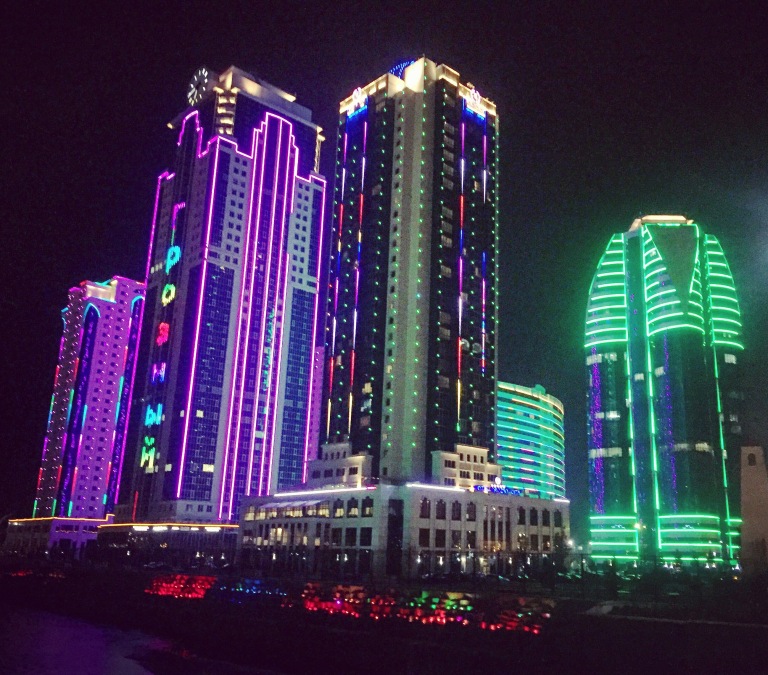
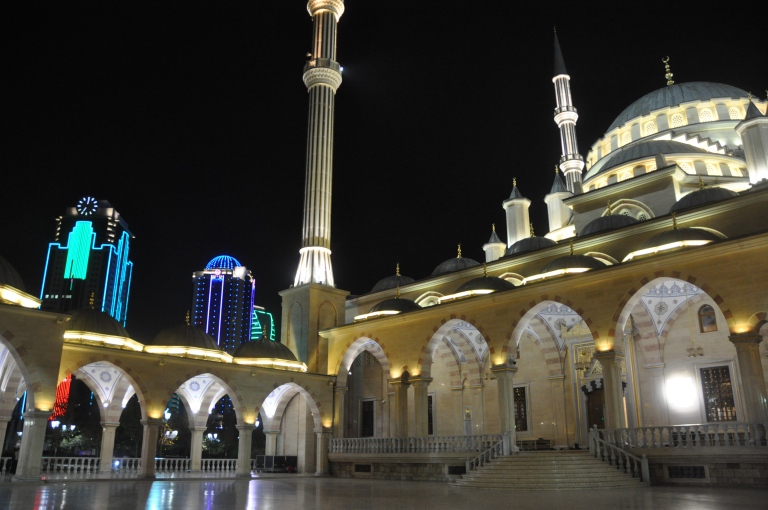
Otherwise, Grozny city itself is a bit of a snooze.

On my first day in Grozny I met this 100% Chechen man that was from what I can tell a sort of golden Chechnya poster-child during the Soviet days. Started as a wrestler in the USSR (as one does in the Caucasus) while also doing some acting in movies. Many Chechens and ex wrestlers then move into the security business as they are known to be very loyal people (as well as scary badasses) – he went to Moscow to work for some kind of bodyguard gang run by Georgians. From what I can tell he is friendly with both Chechens and also the Kadyrov administration. He prefers his Soviet days to the days now in the Russian Federation.
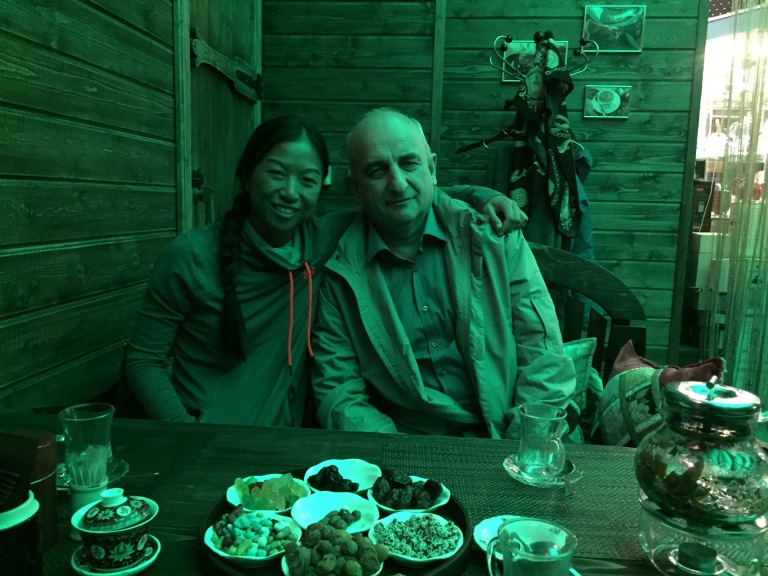
Another day I find myself running around town with Shamil, a Chechen fighter who was held in a Russian prison during the second Chechen War for 3 months in 2000.
Wait, let’s rewind…
Shamil is 50 years old, was born in Grozny and eventually left before the first Chechen War for Moscow to be from what I can tell, a criminal working mainly extorting money from random dignitaries while working in security. After Chechnya “won” the first war Shamil decided to move back to live in the new independent Chechnya. When the second war broke out, he joined the resistance and became a Chechen fighter. At some point he was injured by a flamethrower, forced to flee his location with some men, worked their way down in the river bed (lands were sprinkled with mines everywhere) and ended up at a town just outside Grozny where the Russians caught up to them. Some nurse nuns attached themselves to the group of fighters and refused to leave their side – thus Shamil’s group was spared and they were only imprisoned (killing women and nurses would let the Russians be culpable of “massacre”). And then apparently all you had to do was pay your way out of prison – the Russian soldiers had quite a business going in this. Shamil paid $10,000 for his release and then was offered a position in Putin’s/Kadyrov’s new government post the war which he refused. The Russian FSB still check up on him every few months to see what he’s up to and he remains on a WANTED LIST. Most of his brothers in arms are still wanted and are overseas after having sought political asylum in various European countries. Anything else I’d like to write about Shamil I’ll have to tell you in person…
He later bought me a big bar of chocolate as a gift after he was finally convinced I wasn’t a journalist or spy working for the FSB.

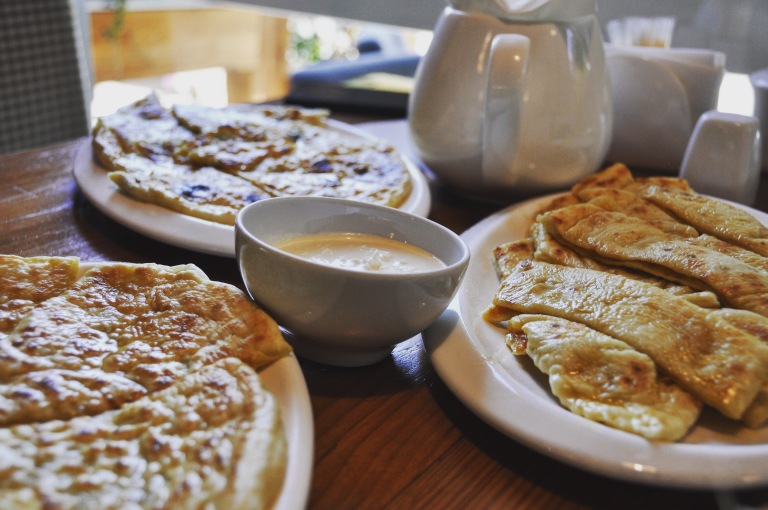

Another night I went looking for an Akhmat Grozny match because I’m curious to see Grozny play – one of the players currently at Akhmat Grozny, Zaur Sadayev 9, briefly played for a very racist Jerusalem club. I recommend an interesting documentary about his time there called Forever Pure. Moscow Spartak is the country’s most successful club having won 12 Soviet championships and 10 Russian championships, and as luck would have it I catch a match between these two teams in Grozny.
The flag you see above in front of you is that of Kadyrov’s Chechnya. Here in Chechnya you see two versions of the flag – this one, and also one with the symbol of Chechnya which is that of independent Chechnya. There are likely hoards of fans hired by the government in the crowd here.


A couple other things I’ve learned about Chechens and Grozny so far, in no particular order:
- Many Chechens (and maybe Russians in general) idolize Native Americans. Apparently in the USSR movies from India (India) and about Native Americans (like the Last of the Mohicans) were extremely popular and some of the only movies allowed. The Soviets only allowed movies about America that showed them in a bad light and preferably violent/cruel – so the Chechens apparently have massive man crushes on Native Americans. I thought this was funny.
- It’s proven difficult to get people to pose for pictures here. Especially if they have an Abe Lincoln beard, they’re worried they will show up in some newspaper being labelled a jihadi. Everybody thinks you’re a journalist, and to be honest with most people I don’t speak with them long enough to convince them otherwise. Men (forget trying to photograph the women) are scared to have their pictures taken.
- Chechen men are ashamed of growing bellies, even when they’re 50. It’s very important to them to stay in respectable shape – in records from the Empire they had even been described as having broad shoulder and small, lean waists. The way one man put it to me, it’s the women having the multiple children, they aren’t carrying any children so what is their excuse? The creeping male belly is shameful.
- They’re into memorials and commemorations but very different treatment allowed publicly for vets or martyrs of the first Chechen War (where Chechnya won but Russia kind of let them) and the second Chechen War (where Russia crushed them). It’s almost like the second war didn’t exist by the looks of museums and memorials around the city.
- Still lots of military everywhere around Grozny (Russian and Chechen forces hired by Russia), but no international peacekeeping forces for a conflict so recent. Probably due to lack of any international involvement.
- Chechens take their gyms, fight clubs, and sports clubs seriously. They are everywhere. Along with camouflage fashion. And Abe Lincoln beards that I can’t take pictures of.
